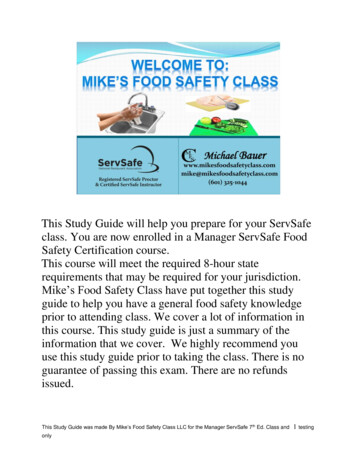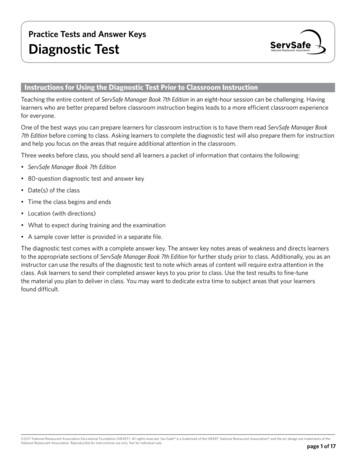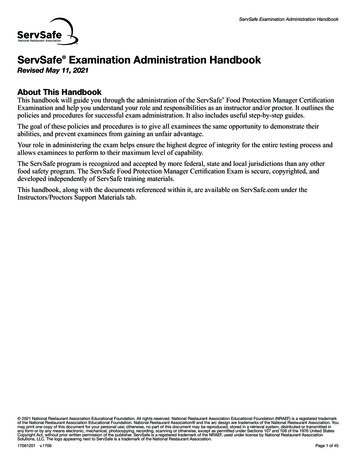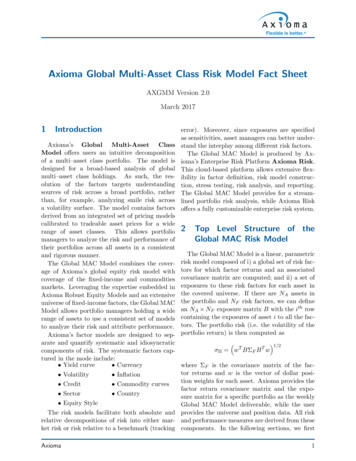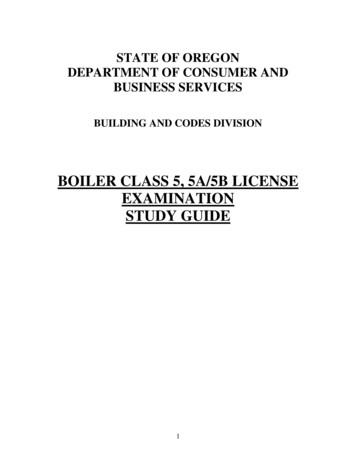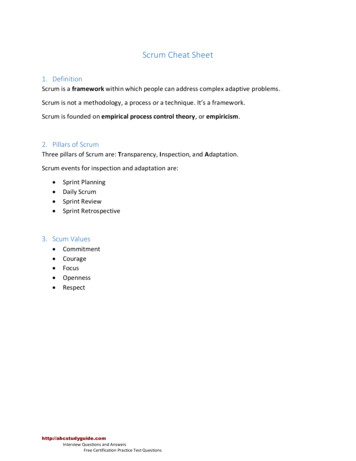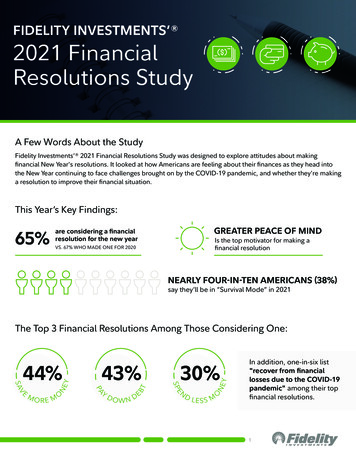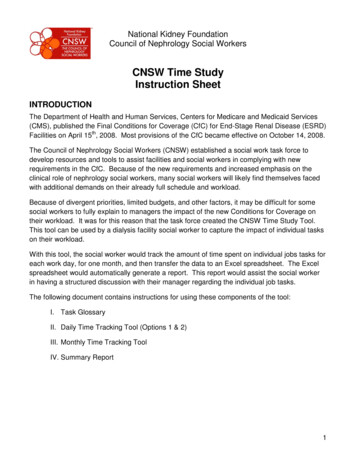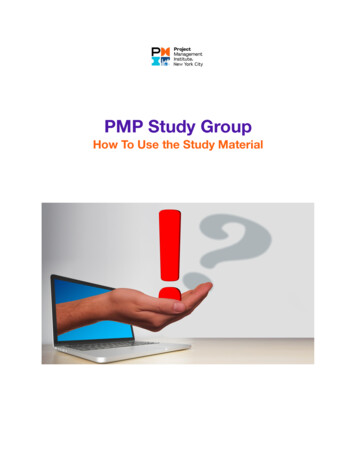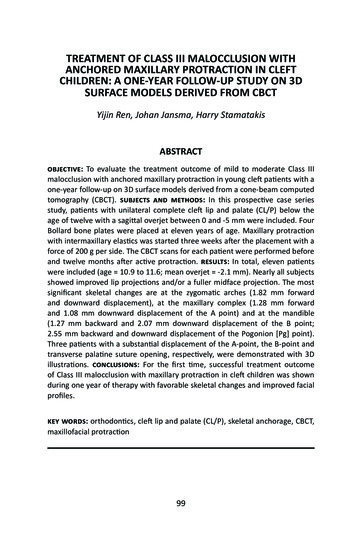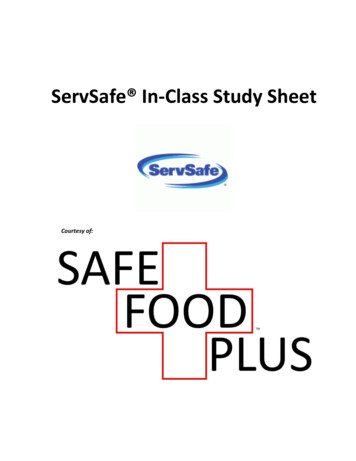
Transcription
ServSafe In-Class Study SheetCourtesy of:
ServSafe In-Class Study SheetCHAPTER 1: Providing Safe Food An illness is considered an outbreak when:o Two or more people have the same symptoms after eating the same foodo An investigation is conducted by state and local regulatory authoritieso The outbreak is confirmed by laboratory analysisThree ways to contaminate food:o Biological (Bacteria, Viruses, Parasites, Fungi)o Chemical (Anything not food including cleaners and sanitizers)o Physical (including bones)Five ways foods become unsafeo Time-Temperature abuseo Cross Contaminationo Personal Hygieneo Poor Cleaning and Sanitizingo Buying from Unapproved Sources (only one not under our control within the store)TCS Foods Foods that are Time and Temperature Controlled for Safetyo Milk and dairyo Eggso Meat, poultry, fisho Shellfish and crustaceanso Baked potatoeso Heat treated plant food (rice, beans, veggies)o Tofu or soy proteino Sprouts and sprout seedso Sliced melons, tomatoes, cut leafy greens (like romaine, spinach, etc.)o Untreated garlic and oil mixturesRTE Ready To Eat foods (no more prep, washing or cooking is needed)Government Agencieso FDA (Food and Drug Administration) Inspects all food not USDA’s job Across state lines Publishes Food Code (as a recommendation for State and local authorities)o USDA (United States Department of Agriculture) Inspects meat poultry and eggs Across state lineso CDC (Centers for Disease Control) and PHS (Us Public Health Service) Do not inspect. Only do research and assist when there is an outbreako State and Local Authorities (i.e.: Health Department) Inspects and enforces locally Investigates complaints Issues license, permits and approves construction and HACCP plans Safe Food Plus, LLC, 20161 Pagehttp://safefoodplus.com
ServSafe In-Class Study SheetCHAPTER 2: Forms of Contamination Common Symptoms of Foodborne Illnesso Diarrhea, vomiting, fever, nausea or abdominal cramps Big 6 (EXCLUDE from ALL work until doctor note saying healthy again)o BACTERIA: Salmonella (Typhi) Humans only in bloodstream and intestines From RTE foods and beverages Wash hands Cook to proper tempso BACTERIA: Salmonella (more common) Farm animals (poultry, eggs, meat, milk and dairy) Produce Prevent cross contamination and cook to proper temperatureso BACTERIA: Shigella From flies and water contaminated by animals Think flies at a picnic: Salads (potato, tuna,shrimp, macaroni, chicken) Wash hands Diarrheao BACTERIA: E. coli Ground beef (cattle) and produce Cook to proper temps Buy from approved suppliers Prevent cross contaminationo VIRUS: Hep A RTE food and Shellfish Wash hands Jaundiceo VIRUS: Norovirus RTE food and shellfish Wash hands Vomiting and diarrhea Bacteriao Cannot be seen, smelled or tastedo Needs FATTOM: Food Acidity (little or no acid 4.5-7 pH)Most Temperature (Danger Zone 41 F-135 F)controllable Time (more time in the Danger Zone more change for bacterial growth) Oxygen (some need it, some don’t) Moisture (the more water the more bacteria can grow) Safe Food Plus, LLC, 20162 Pagehttp://safefoodplus.com
ServSafe In-Class Study Sheet Viruseso Cooking does not kill a viruso Do not grow in food but require humans of animals to be transferredParasiteso Not as common as bacteria and viruso Seafood, wild game, food processed with contaminated watero Cook properlyo Buy from reputable supplierFungio Yeasts, mold, mushroomso Grows well in high acidic food with low moistureToxinso Can be produced in plants and mushroomso Can be produced in seafood: tuna, bonito, mahi mahi.o Ciguatera Toxin: Barracuda, snapper, grouper, amberjacko Symptoms: Diarrhea or vomiting Tingling in extremities and hot/cold flashes Flush in face / hives, difficulty breathing, heart racingChemical Contaminantso Pewter, copper, zinc cooking equipmento Cleaners, first aid items, beauty products, etc. (anything not food)Physical Contaminantso Includes bones plus all obvious items (plastic, bandages, rocks, etc.) ALERT (prevention against terrorism and deliberate contamination of food)o Assureo Looko Employeeso Reportso Threat Allergenso Symptoms very similar to toxin, but no tingling in extremities or hot / cold flasheso Big 8: Milk and eggs Fish and crustacean shellfish (lobster, shrimp, crab) Tree nuts (almonds, walnuts, pecans) and peanuts Soy and wheat (gluten)o Don’t cross contaminate, do wash hands often, and always offer ingredients Safe Food Plus, LLC, 20163 Pagehttp://safefoodplus.com
ServSafe In-Class Study SheetCHAPTER 3: The Safe Food HandleroooooooHand washingo 20 seconds total (10-15 seconds for scrubbing)o 100 F watero Turn off faucet with hand towelo Hand antiseptic is NEVER a substituteInfected wound on hand must be covered with impermeable bandage and single-use gloveSingle-use gloves are required to be used all times EXCEPT:o Washing produceo Handling RTE ingredients that will be added to a dish to be cooked to proper tempsNever blow into gloves or roll them up before putting onOnly jewelry allowed is plain band ringAprons must be removed when leaving the food prep area (especially restroom!)100 FHandling Illnesses:o Sore throat with fever: Restrict from food OR – Exclude if serving high-risk population Doctor’s note is required to returno Vomiting or Diarrhea EXCLUDE, no exceptions Can return after EITHER no symptoms for 24 hours OR doctor’s note “Strict” cleaning and sanitizing procedureso Jaundice Exclude employee Report to local health authority Can return after 7 days AND a doctor’s noteCHAPTER 4: Introduction to the Flow of FoodoPreventing cross contaminationo Use separate equipment for each itemo Clean and sanitize equipment after every useo Prep food at efficient timeso Buy foods that don’t require preppingoPreventing Time and Temperature Abuseo Danger Zone is 41 F - 135 F Bacteria grows fastest between 70 F - 125 F TIP: Take out only what you need to prep Monitor and record temps and times whenever critical point exists (to bestudied further in chapter 8) Safe Food Plus, LLC, 20164 Pagehttp://safefoodplus.com
ServSafe In-Class Study SheetoThermometerso Bimetallic 0 F - 220 F Measures from tip to dimple through the stemo Thermocouples and Thermistors Measures temps using only the tip of the probe Immersion probe For liquids like soups, sauces and frying oil Surface probe For flat cooking equipment like griddles Penetration probe For internal temp of foods Air probe For inside coolers and ovenso Infrared Checks surface temp using laser light It cannot read through a clear object!oThermometer Guidelineso Must be washed, rinsed and sanitized after every use to avoid cross contaminationo Recalibrate at the beginning of every shift and whenever droppedo Accuracy must be within /- 2 F (**air thermometers must be accurate to /- 3 F)o Glass thermometers cannot be used without shatterproof casingo Always check temps in two different spots in food /-3 F /-2 FCHAPTER 5: Purchasing, Receiving and StorageoooAlways use approved, reputable suppliersVisually inspect every delivery immediately when it arrivesReject food if:o Packaging is damaged (tears, holes or punctures)o Cans are missing labels, bulging, swollen, rusty or dentedo Product is leaking or seals are brokeno Product dates are expiredo Frozen food shows ice crystals or water stainso Temp of product not correct: 41 F or lower all cold food 45 F or lower shucked shellfish, surface temp of live shellfish, milk and eggs Live shellfish must also not have an internal temperature more than50 F All foods must be then cooled to 41 F or lower within 4 hours Shellfish must have shellstock ID tags (keep for 90 days after the lastshellfish from that stock was used) 135 F or higher all hot food Safe Food Plus, LLC, 20165 Pagehttp://safefoodplus.com
ServSafe In-Class Study SheetoLabelingo All food must be labeled with common name and date marking if not in originalcontainero Food packaged on-site for retail sales must be labeled with: Common name Quantity of food List of ingredients List of artificial colors and flavors, as well as preservatives Name and place of manufacturer, packer or distributor Source of major food allergen (unless it’s already part of the common name)oDate Markingo All food must be date marked is held for longer than 24 hourso RTE food can be stored for only 7 days if held at 41 F or lowero When combining food, the date to discard will always be the earliest of the foodso FIFO First In First OutoStorageo Food must be 6” off the groundo Do not over pack coolers. Leave room for air to flow.o Store food only in containers intended for food that are durable, leak proof and able tobe sealed or coveredo Storage order on shelves (top to bottom): RTE food Seafood Whole cuts of beef and pork Ground meat and ground fish Whole poultryo Never store food in areas not designed for foodCHAPTER 6: PreparationooNever misrepresent the food with additives, overwraps or lightsThawing: 4 Methodso In cooler at 41 F or lower (BEST METHOD)o Submerged completely under running water at 70 F or less(keeping the food always 41 F or lower in the process)o In microwave ONLY if being cooked by conventional methods immediately aftero Thaw as part of the cooking process Safe Food Plus, LLC, 20166 Pagehttp://safefoodplus.com
ServSafe In-Class Study SheetoROP Reduced Oxygen Packagingo If ROP package says must remain frozen until use then EITHER: Remove from package THEN thaw using cooler method, OR Remove from package AFTER thawing using running water method.oProduceo Wash before cutting, cooking or combining with other ingredientso Do not mix different produce when cleaning or giving ice batho Melons, tomatoes and leafy greens do not need to be held at temp until cut,then they must be held at 41 F or lower like all RTE food.oUse pasteurized eggs if they are to be pooled, then cook immediately or store at 41 F or loweroVariances – Documents issued by regulatory authority that allows a requirement to be waivedo Packaging juice on-siteo Smoking food to preserve it (but not to enhance flavor!)o Using food additives to eliminate need to time and temperature controlo Curing foodo Custom-processing animals for personal useo ROP (includes MAP, vacuum-packed and sous vide)o Sprouting seeds or beanso Live shellfish from a display tankoCooking Temps (“Please Give Safe Food!”)o 165 F – Poultry, stuffed meat, reheatingo 155 F – Ground meat, ground seafood, injected meat, ratites (ostrich, emu), eggs LATERo 145 F – Seafood, Steaks (pork, beef, veal, lamb, eggs NOWo 135 F – Fruits, veggies and grainsAbove are all for 15 seconds of holding time at the temperature listed.Only exception is roasts of pork, beef, veal or lamb, which is 145 F for 4 minutesoooMicrowave Cookingo Stir / rotate halfway through cooking processo Let stand two minutes when done to even tempso Check temps in two placesoPartial Cookingo Never cook longer than 60 minutes if partial cooking an itemo Cool food immediatelyo Properly freeze or cool foodo Heat properly before selling or servingRaw or undercooked items must have a Consumer Advisory listedNever serve raw or undercooked items to a high-risk populationoo Safe Food Plus, LLC, 20167 Pagehttp://safefoodplus.comMEMORIZE
ServSafe In-Class Study SheetoCooling Timeo 135 F to 70 F in two hourso 70 F to 41 F in four hourso NOTE: TOTAL of six hours, means it could be 1 hour then 5 hours, but 135 F to 70 Fmust be done within 2 hours still.oCooling Methodso Food cools faster when smaller portions or in shallower containerso Use ice water bath, or stir with paddle or blast chillero When storing for further cooling, keep lid loose or uncovered (if safe)CHAPTER 7: ServiceoWhen holding food to temp: Check temperatures at least every 4 hoursoWhen holding food without temperature control:o Hot food no longer than 4 hours Started at 135 F or higher It has a date label stating when it started and when it needs to be thrown out It is thrown out after 4 hourso Cold food no longer than 6 hours if: Started at 41 F or lower Never gets above 70 F It has a date label stating when it started and when it needs to be thrown out It is thrown out after 6 hours46oPreset tablewareo Must be wrapped or covered if preseto Must either be removed if not needed when guests are sat or cleaned and sanitizedwhen they leave, even if it was never used.oTake home containers (like refill beverage cups at a convenience store, etc.)o Must be designed to be reusedo Must be provided by the food establishmento Must be cleaned and sanitized properly before refilling Safe Food Plus, LLC, 20168 Pagehttp://safefoodplus.com
ServSafe In-Class Study SheetoNever reserve:o Food returned by a customero Uncovered condimentso Uneaten bread (not to be made into croutons!)o Plate garnishesoSelf-serve / Buffeto Sneeze guards (7’ back, 14 “ tall)o Must have clean plate when returning to get more foodo Never use ice as an ingredient if it was used to keep food coldo Labels must mark bulk foods if there is a health claim (i.e.: gluten free, etc.), otherwise,as long as it was produced on-site or off-site with the same company, it is not neededCHAPTER 8: Food Safety Management SystemsoooExamples of Food Safety Management Systemso Personal hygiene programo Food safety trainingo Supplier selection and specification programo Quality control and assurance programso Cleaning and sanitation programo Standard operating procedures (SOPs)o Facility design and equipment maintenance programo Pest-control program12HACCP (Hazard Analysis Critical Control Point)1. Conduct a hazard analysis2. Determine critical control points (CCPs)3. Establish critical limits4. Establish monitoring procedures5. Identify corrective actions6. Verify that the system works7. Establish procedures for record keeping and documentation4165356HACCP in Action (simplified)1. Grilled chicken on the menu could get peopl
ServSafe In-Class Study Sheet 2 P a g e Safe Food Plus, LLC, 2016 http://safefoodplus.com Most controllable CHAPTER 2: Forms of Contamination
